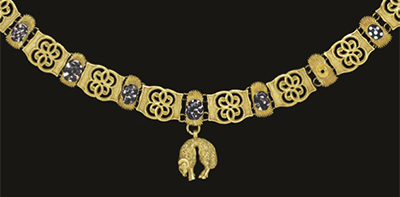A time of reform and experimentation
The military reforms of Charles VII: the creation of the modern army
In the Middle Ages, the King of France was the head of an army comprised of his vassals. In order to fund a military campaign, he had to gather the États généraux, an assembly which had the authority to decide whether or not to impose an extraordinary tax: the land tax. Charles VII reformed this system.
He gradually managed to convince the États généraux to make the land tax permanent.
With this new source of funding, he promulgated a ruling on 26 May 1445 called the Grande Ordonnance de Louppy-le-Château, which established the foundations for a permanent army made of 15 companies at the exclusive service of the King.
Fifteen captains, chosen based on their birth and their strengths, were made responsible for putting together a company of 100 lance units each. The lance, which was a tactical unit, comprised four combatants: one unit leader, two archers and one coutilier in addition to two mounted auxiliaries. Charles VII thus had a permanent army of 9,000 men who were paid in both times of war and peace.
- The Petite Ordonnance provided for the mortes-payes, which were lances reduced to four members assigned to the garrisons of strongholds.
- The Franc-archers, created in 1448, were a militia of commoners. Exempted from tax because of their military service, they were the reserve of the permanent army.
1453: Castillon and the end of the Hundred Years' war
In 1450, the Battle of Formigny put an end to the Hundred Years’ War in the north part of the kingdom.
Three years later on 17 July 1453, the Battle of Castillon put a definitive end to the conflict. The French artillery, led by the brothers Jean and Gaspard Bureau, played an important role. The French camp was defended by a ditch in which the artillery was positioned, hidden from the sight of the English. John Talbot, the famous English military commander, then about 60 years old, attacked the French camp with an army of 6,000 men. They were decimated by the firepower of the French artillery. Talbot himself was killed during the confrontation and the English army was destroyed in Guyenne.
After the battle, the main strongholds of Guyenne fell into the hands of the French. Bordeaux opened its gates in October 1453. Charles VII became the ‘Victorious King’.
Zoom
The knights' orders
Born in the middle of the 14th century, the knights’ orders were gathered under the authority of a prince, constituting a limited number of high-ranking noblemen. This new category of nobility was based on a chivalrous ideal of valour, courtesy and loyalty, with the latter value often overriding military virtues.
In 1430, Philip the Good, Duke of Burgundy, founded the Order of the Golden Fleece, a prestigious distinction in medieval times awarded to 31 knights close to the duke. This number grew to 51 under the future emperor Charles V. The necklace symbolises the bonds of fraternity between knights of equal ranking. It is made of separate pieces of briquette and flint attached to each other. In response to his rival, Louis XI created the Order of Saint Michael in 1469 in appeal to the protection of the archangel, the patron saint of the kingdom of France. The Order of the King was limited to 30 holders of the title who wore a necklace of shells and bows on which was hung a medallion depicting the archangel vanquishing the devil.
The footsoldier: the formidable strength of modern armies
Whether they were members of the Swiss contingents, German lansquenets paid by the King of France or part of the French companies, footsoldiers were divided into three tactical specialisations: The pikemen, armed with pikes over five metres long, formed a spike that was intended to stop the cavalry charges while equal numbers of halberdiers attacked the gendarmes, stopping them in their tracks with the edge or the point of their weapons. Smaller numbers of joueurs d’épée, armed with large swords which they wielded with both hands, cut down or fought back adversary’s flanks, creating breaches within these very dense units for whom cohesion and discipline were vital.
Arquebusiers and crossbowmen made up only 10% of ground troops. These ‘lost children’, as they were called in the 16th century, fought as infantry in front of the battalions of footsoldiers. Just before the shock, they would nimbly take cover behind the pikemen.


















